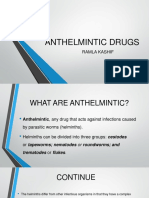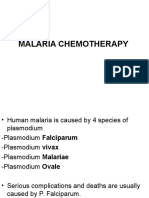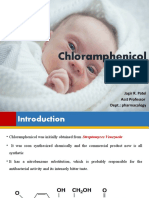0 ratings0% found this document useful (0 votes)
34 viewsOxamniquine
Oxamniquine
Uploaded by
Mtw WondOxamniquine is an alternative treatment to praziquantel for Schistosoma mansoni infections. It is effective against both mature and immature stages of S. mansoni by causing contraction and paralysis of the worms. It has been used for mass treatment and can be effective against praziquantel-resistant strains. It is absorbed orally but is not effective against S. haematobium or S. japonicum.
Copyright:
© All Rights Reserved
Available Formats
Download as PPTX, PDF, TXT or read online from Scribd
Oxamniquine
Oxamniquine
Uploaded by
Mtw Wond0 ratings0% found this document useful (0 votes)
34 views7 pagesOxamniquine is an alternative treatment to praziquantel for Schistosoma mansoni infections. It is effective against both mature and immature stages of S. mansoni by causing contraction and paralysis of the worms. It has been used for mass treatment and can be effective against praziquantel-resistant strains. It is absorbed orally but is not effective against S. haematobium or S. japonicum.
Original Title
Presentation
Copyright
© © All Rights Reserved
Available Formats
PPTX, PDF, TXT or read online from Scribd
Share this document
Did you find this document useful?
Is this content inappropriate?
Oxamniquine is an alternative treatment to praziquantel for Schistosoma mansoni infections. It is effective against both mature and immature stages of S. mansoni by causing contraction and paralysis of the worms. It has been used for mass treatment and can be effective against praziquantel-resistant strains. It is absorbed orally but is not effective against S. haematobium or S. japonicum.
Copyright:
© All Rights Reserved
Available Formats
Download as PPTX, PDF, TXT or read online from Scribd
Download as pptx, pdf, or txt
0 ratings0% found this document useful (0 votes)
34 views7 pagesOxamniquine
Oxamniquine
Uploaded by
Mtw WondOxamniquine is an alternative treatment to praziquantel for Schistosoma mansoni infections. It is effective against both mature and immature stages of S. mansoni by causing contraction and paralysis of the worms. It has been used for mass treatment and can be effective against praziquantel-resistant strains. It is absorbed orally but is not effective against S. haematobium or S. japonicum.
Copyright:
© All Rights Reserved
Available Formats
Download as PPTX, PDF, TXT or read online from Scribd
Download as pptx, pdf, or txt
You are on page 1of 7
OXAMNIQUINE
• Oxamniquine is an alternative to praziquantel for the treatment of S
mansoni infections.
• It has also been used extensively for mass treatment.
• It is not effective against S haematobium or S japonicum.
Anthelmintic Actions
• Oxamniquine is active against both mature and immature stages of S
mansoni but does not appear to be cercaricidal.
• The mechanism of action is unknown.
• Contraction and paralysis of the worms results in detachment from
terminal venules in the mesentery and transit to the liver.
• Oxamniquine has been effective in instances of praziquantel resistance.
Clinical Uses
• safe and effective in all stages of S mansoni disease, including
advanced hepatosplenomegaly.
• results disappearance of acute symptoms and clearance of the
infection in treatment of acute (Katayama) syndrome.
• used in combination with metrifonate for mixed schistosome
infections
• Optimal dosage schedules vary for different regions of the world.
• less effective in children
• better-tolerated with food.
Pharmacokinetics
• Oxamniquine is readily absorbed orally.
• Its plasma half-life is about 2.5 hours.
• The drug is extensively metabolized to inactive metabolites and
excreted in the urine up to 75% in the first 24 hours.
• Intersubject variations in serum concentration have been noted,
which may explain some treatment failures.
Adverse Reactions
• Central nervous system symptoms (dizziness, headache, drowsiness)
are most common.
• Nausea and vomiting, diarrhea, colic, pruritus, and urticaria also occur
Infrequently
• May cause low-grade fever, an orange to red discoloration of the
urine, proteinuria, microscopic hematuria, and a transient decrease in
leukocytes.
• Seizures have been reported rarely.
Contraindications
• Since the drug makes many patients dizzy or drowsy, it should be used
with caution in patients whose work or activity requires mental
alertness.
• should be used with caution in those with a history of epilepsy.
• contraindicated in pregnancy
Doxycycline
• tetracyclic antibiotic agent
• has recently been shown to have significant macrofilaricidal activity
against W bancrofti
• has activity against onchocerciasis.
• Doxycycline with ivermectin has complementary therapy for the
control of onchocerciasis.
• Can reduce the transmission and occurrence of onchocercal eye
disease.
You might also like
- AminoglycosidesDocument41 pagesAminoglycosidesAshish NeupaneNo ratings yet
- AminoglycosidesDocument20 pagesAminoglycosidesHassan.shehri100% (5)
- Antimalarial DrugsDocument45 pagesAntimalarial Drugsdyavaraharika2024No ratings yet
- General Outline For Antibiotics: Chemistry - MIP Effect On Microbes - MIPDocument43 pagesGeneral Outline For Antibiotics: Chemistry - MIP Effect On Microbes - MIPWilliam WongNo ratings yet
- Anthelmintic DrugDocument39 pagesAnthelmintic DrugBolanle OjokohNo ratings yet
- Anthelmintic DrugsDocument35 pagesAnthelmintic DrugsRamla KashifNo ratings yet
- Antibiotik Dan Antiseptik Saluran KemihDocument14 pagesAntibiotik Dan Antiseptik Saluran KemihPuterinugraha Wanca ApatyaNo ratings yet
- Malaria ChemotherapyDocument74 pagesMalaria ChemotherapyGeorge C. KasondaNo ratings yet
- Antihelminths: DR Japhet Mangoyi Department of Clinical PharmacologyDocument15 pagesAntihelminths: DR Japhet Mangoyi Department of Clinical PharmacologyMitchelle SaurambaNo ratings yet
- Antimalarial Drugs: Presenter Basil Mupita Rgn/BscneDocument35 pagesAntimalarial Drugs: Presenter Basil Mupita Rgn/BscneTapiwaNo ratings yet
- Lecture 4 Protien Synthesis InhibitorsDocument45 pagesLecture 4 Protien Synthesis InhibitorsAbrarAhmadAl-ekishNo ratings yet
- Antihelminthic DrugsDocument35 pagesAntihelminthic Drugsdyavaraharika2024No ratings yet
- Chloramphenicol: Jagir R. Patel Asst Professor Dept.: PharmacologyDocument17 pagesChloramphenicol: Jagir R. Patel Asst Professor Dept.: PharmacologyJagirNo ratings yet
- Antibiotics: Presented By: Bruan, Maria Aida Lumico, Moira Panti, John Christopher Libid, Teryl David, RafaelDocument44 pagesAntibiotics: Presented By: Bruan, Maria Aida Lumico, Moira Panti, John Christopher Libid, Teryl David, RafaelLouie BruanNo ratings yet
- Pharmacology-Unit-III (F) AntimalarialdrugsDocument59 pagesPharmacology-Unit-III (F) Antimalarialdrugswebpixel services100% (1)
- Amikacin SulfateDocument4 pagesAmikacin SulfateCay SevillaNo ratings yet
- Clin Phar NursDocument107 pagesClin Phar NursTadela MengashaNo ratings yet
- Presentation 6Document13 pagesPresentation 6chetan panwarNo ratings yet
- ANTIMALARIAL DrugsDocument25 pagesANTIMALARIAL DrugsMANAS ChhapoliyaNo ratings yet
- Cefixime: Suprax Class and CategoryDocument3 pagesCefixime: Suprax Class and CategoryArianne Joy SalvadorNo ratings yet
- Protein Syntheis InhibitersDocument43 pagesProtein Syntheis InhibitersMona AdamNo ratings yet
- ChloramphenicolDocument20 pagesChloramphenicolPROF DR SHAHMURAD100% (2)
- B. AntibioticsDocument38 pagesB. AntibioticsKim Shyen BontuyanNo ratings yet
- Non Steroid Antiinflammatory Drugs & Drugs Use in The Treatment of GoutDocument28 pagesNon Steroid Antiinflammatory Drugs & Drugs Use in The Treatment of GoutVevi VarcetyNo ratings yet
- Antimalarialdrugs 200419172207Document31 pagesAntimalarialdrugs 200419172207hamnahameed21No ratings yet
- Antimikroba Dan Antiviral Pada Abdominal CompaintDocument86 pagesAntimikroba Dan Antiviral Pada Abdominal CompaintYulia KasihNo ratings yet
- SulfonamidesDocument2 pagesSulfonamidesabcdeNo ratings yet
- NUR138 Lecture 8 38-39Document65 pagesNUR138 Lecture 8 38-39FeliciaDorghamNo ratings yet
- AnthelminticsDocument5 pagesAnthelminticsDrx Harish PatelNo ratings yet
- MACROLIDESDocument51 pagesMACROLIDESKasturiRangan SrivatsaNo ratings yet
- Anti InfectivesDocument40 pagesAnti InfectivesIconMaicoNo ratings yet
- Drugs For Treating UTIDocument11 pagesDrugs For Treating UTIEbenezer SamuelNo ratings yet
- Kuliah Farmakologi - Farmakokinetik Dan Farmakodinamik Antivirus Dan Antiparasit Secara UmumDocument87 pagesKuliah Farmakologi - Farmakokinetik Dan Farmakodinamik Antivirus Dan Antiparasit Secara UmumGabriel AnindhitaNo ratings yet
- Pharmacology of Antituberculosis Drugs: DR - Datten Bangun MSC, SPFK Dept - Farmakologi & Terapeutik Fak - Kedokteran UhnDocument45 pagesPharmacology of Antituberculosis Drugs: DR - Datten Bangun MSC, SPFK Dept - Farmakologi & Terapeutik Fak - Kedokteran UhnPutri Rahmi MaharaniNo ratings yet
- IPD Pharmacology - FULLDocument57 pagesIPD Pharmacology - FULLMFC 2019No ratings yet
- Antibacterial Class 03Document80 pagesAntibacterial Class 03tsegaab yosephNo ratings yet
- Anti InfectivesDocument145 pagesAnti Infectivescharles babasaNo ratings yet
- Anti Malarial Drugs by Salaria AnamikaDocument10 pagesAnti Malarial Drugs by Salaria AnamikaSalaria Anamika100% (1)
- To Pi Ram AteDocument3 pagesTo Pi Ram Ateapi-3797941No ratings yet
- Anti Cancer DrugsDocument54 pagesAnti Cancer DrugsArun JakharNo ratings yet
- 12 MalariaDocument61 pages12 MalariaMewael TesfamichaelNo ratings yet
- D. Antiviral Antiprotozoal AntihilmenticsDocument31 pagesD. Antiviral Antiprotozoal AntihilmenticsKim Shyen BontuyanNo ratings yet
- Tungul - Activity 1 Midterms (Pharmacology)Document6 pagesTungul - Activity 1 Midterms (Pharmacology)Ma. Rita Concepcion TungulNo ratings yet
- SupriyaDocument15 pagesSupriyaprajwal karkiNo ratings yet
- Anti Microbials (Repaired)Document79 pagesAnti Microbials (Repaired)drsidra.mustafaNo ratings yet
- CHLOROQUINEDocument6 pagesCHLOROQUINEKarla Camille de LeonNo ratings yet
- Chemotherapy of Protozoal InfectionsDocument34 pagesChemotherapy of Protozoal InfectionsSri RamNo ratings yet
- Aminoglycosides: Pharmacology & TherapeuticsDocument24 pagesAminoglycosides: Pharmacology & TherapeuticsMarieNo ratings yet
- Antidepressants 266: JSS College of Pharmacy, MysuruDocument68 pagesAntidepressants 266: JSS College of Pharmacy, MysurucrissNo ratings yet
- Pharmacology and Toxicology Week 4Document32 pagesPharmacology and Toxicology Week 4Melvin LiewNo ratings yet
- Drug StudyDocument6 pagesDrug StudyMiru มิริวNo ratings yet
- Antipsychotic Drug:: Second Generation AtypicalDocument30 pagesAntipsychotic Drug:: Second Generation AtypicalMaryGraceVelascoFuentesNo ratings yet
- Valproic AcidDocument4 pagesValproic Acidapi-3797941100% (2)
- Pharma Review FinalsDocument31 pagesPharma Review FinalsLanz Andrei MatociñosNo ratings yet
- Ik. AntihelminthsDocument17 pagesIk. AntihelminthsTariku BogaleNo ratings yet
- Aminoglycosides and Polypeptide AntibioticsDocument28 pagesAminoglycosides and Polypeptide Antibioticsjosephdeborah60No ratings yet
- Anti Malarial, Anti Viral, Anti Fungal, Anti Amoebic DrugsDocument12 pagesAnti Malarial, Anti Viral, Anti Fungal, Anti Amoebic Drugslipsa mahukaNo ratings yet
- Antiepileptic Drugs: Department of Pharmacology Zhang Yan-MeiDocument28 pagesAntiepileptic Drugs: Department of Pharmacology Zhang Yan-MeiDrMohammed AlyNo ratings yet
- Top 100 Drugs Pocket Reference Guide (2023 Edition)From EverandTop 100 Drugs Pocket Reference Guide (2023 Edition)No ratings yet
- Concise Guide to Clinical Dentistry: Common Prescriptions In Clinical DentistryFrom EverandConcise Guide to Clinical Dentistry: Common Prescriptions In Clinical DentistryNo ratings yet
- Analytical Errors & Validation of Analytical ProceduresDocument61 pagesAnalytical Errors & Validation of Analytical ProceduresMtw WondNo ratings yet
- 12 - Conductometry, Coulometry & PolarographyDocument68 pages12 - Conductometry, Coulometry & PolarographyMtw WondNo ratings yet
- 4 - Non-Aqueous Titrimetry AnalDocument29 pages4 - Non-Aqueous Titrimetry AnalMtw WondNo ratings yet
- Complexcometric PPTDocument50 pagesComplexcometric PPTMtw WondNo ratings yet
- Sales Free SeminarDocument63 pagesSales Free SeminarMtw WondNo ratings yet
- 4 AntipsychoticDocument109 pages4 AntipsychoticMtw Wond100% (1)
- 6 - Complexcometric TDocument54 pages6 - Complexcometric TMtw WondNo ratings yet


































































